Home | Airshows | The Hangar | Nostalgia | Links
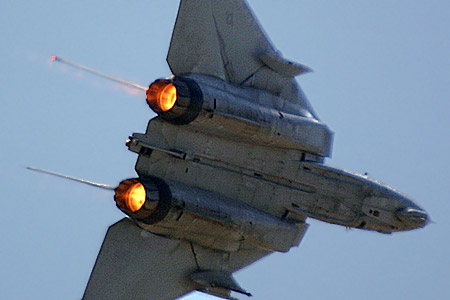 Stars
out at MacDill
Stars
out at MacDill
Guilherme Bystronski reviews a good start to his season in Florida
Although I had attended an airshow at MacDill AFB in 2001, AirFest 2004 wasn't really in my plans for this year, since I had planned to go to NAS Lemoore instead. However, after seeing the performers' list crammed with juicy items, there was no way I could avoid heading to sunny and warm Florida once again. Seldom I have made a better choice in my life!
MacDill AFB is located some five miles south of downtown Tampa, being very close to the heart of the city. Originally known as Southeast Air Base, MacDill AFB started in 1941 as a training base for B-17 crews, and Pearl Harbor was responsible for it becoming one of the main staging areas for Army Air Corps flight crews and aircraft heading to the Far East. 1942 brought to the base the B-26 Marauder, one of the toughest bombers to fly during World War II. In a short span of one year, nine of the twelve combat groups that flew the Marauder in Europe were activated and trained at MacDill. B-17s were back at the base by 1943, and pilots were trained to fly the Flying Fortresses until 1945, when the first B-29s arrived.
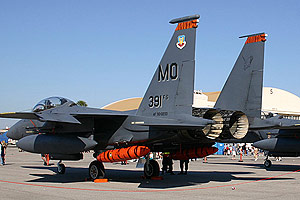
|
Macca
magic
|
 |
 |
 |
 |
 |
 |
 |
 |
 |
 |
 |
 |
 |
 |
 |
 |
 |
 |
 |
 |
 |
 |
 |
After the end of World War II, MacDill became an operational base for Strategic Air Command, with training activities focused around P-51, B-29, and B-50 training. It greeted the B-47 Stratojet bomber and KC-97 tanker aircraft in 1951, becoming a strategic bombardment and air refuelling base. The base started training pilots in F-84s in 1962, and, after becoming a TAC base in 1963, its two combat-ready F-4 Phantom wings (the 12th and 15th TFW) were deployed to Vietnam. In 1970 the 1st TFW moved to MacDill, and was replaced by the 56th TFW in 1975, which received its first F-16s in 1979.
From 1979 to 1993, MacDill AFB trained almost half of all USAF F-16 pilots, but, with the decision to close the base, all flying operations were cancelled by 1993, and its fighters were transferred to Luke AFB, Arizona. Due to its strategic location and flightline capabilities, it was decided to bring the 6th AMW and its KC-135Rs to MacDill, and it has since then contributed to military operations around the world.
Although the base has been fully operational since 1996, there were no airshows scheduled for either 2002 and 2003, due to 9/11 and the constant threat of terrorist attacks. 2004 brought a change to all that, and an airshow was once again scheduled. Coupled with a weekend of perfect weather and temperatures in the 20s, MacDill's AirFest 2004 had all ingredients necessary for a great airshow, which it surely was.
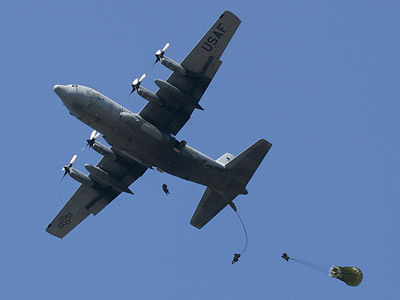 The
static displays were well-organised, with most fighters being roped, although
larger aeroplanes were not. One has to take into account that roping aeroplanes
is not common practice in the US, so I was pleased to find out that taking
pics of the statics would not be the nightmare that it usually is. And
there was plenty to take pictures of, since among the planes parked on
the tarmac there were a C-5, a C-17, a C-141, a couple of C-130s, many
KC-135Rs, a B-52, a KC-10, a B-17, a few F-16s and F/A-18s, a F-14, two
F-15Es, a F-117, an EA-6B, a P-3, an E-6, and several T-38s, T-45s, T-37s,
and T-6s. Although there wasn't a lot of time to browse the statics (only
one hour before and one after the show, since the based closed at 1700),
there was enough time for shooting pics, since the base is not that big.
The
static displays were well-organised, with most fighters being roped, although
larger aeroplanes were not. One has to take into account that roping aeroplanes
is not common practice in the US, so I was pleased to find out that taking
pics of the statics would not be the nightmare that it usually is. And
there was plenty to take pictures of, since among the planes parked on
the tarmac there were a C-5, a C-17, a C-141, a couple of C-130s, many
KC-135Rs, a B-52, a KC-10, a B-17, a few F-16s and F/A-18s, a F-14, two
F-15Es, a F-117, an EA-6B, a P-3, an E-6, and several T-38s, T-45s, T-37s,
and T-6s. Although there wasn't a lot of time to browse the statics (only
one hour before and one after the show, since the based closed at 1700),
there was enough time for shooting pics, since the base is not that big.
But the
flying displays were the main attraction of the show, having a few gems
that rarely are seeing together at the same place. The flying started
each day with a KC-135R taking off to greet the incoming public, which
was followed by the US national anthem. A couple of C-130s were next,
and they were responsible for one of the most interesting displays of
the weekend, dropping quite a few parachute jumpers over the base. Civilian
performers were also invited to the show, with Steve Coan (sailplane),
Bill Leff (T-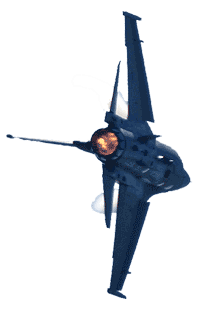 6),
Lee Lauderback (TF-51), and Larry Kelly (B-25) performing very entertaining
displays.
6),
Lee Lauderback (TF-51), and Larry Kelly (B-25) performing very entertaining
displays.
It was then time for jet noise, and the Starfighters Team provided a lot of it! Flying a single-ship demo with the two-seat blue CF-104D, it was as exciting as the military displays that followed it. The only difference is that the Starfighter attracts one's attention even on the ground, since the noise produced by the F-104's intake/engine combination is responsible for one of the most amazing sounds in the airshow circuit. It's a show after the show, and one that pics can't unfortunately capture!
The F-15 East Coast Demo Team out of Langley AFB followed the Starfighter, and it was as good as any Eagle display I've ever seen. On Saturday the Heritage flight (flown by Lee Lauderback's P-51, the F-15, and a F-16) followed the Eagle's display, with the Viper East Coast Demo Team out of Shaw AFB performing last. On Sunday there was a small change in the schedule, and the Viper performed its display before joining the Eagle and Mustang in the Heritage Flight. It always impresses me to see how much bigger the Eagle is compared to the P-51 and even to the F-16 - and their formation looked even better in the blue skies that prevailed during the weekend.
The aerobatic
displays followed, and so did a visit to the burger tent, although Ed
Shipley (Pitts), Tim Weber (Extra 300), Ian 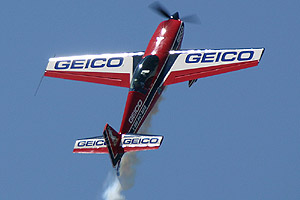 Groom
(Su-31), and Frank Ryder (Cyclone) are among the best aerobatic pilots
in the US airshow business. But the star of the airshow was next, and
I wouldn't miss it for anything: the VF-101's F-14D Tomcat. In probably
its last airshow season, the Tomcat is a sight that will sorely be missed
at airshows. Its performance was greeted by the loudest cheers of the
day, and it would have deserved the top prize of the airshow if there
was one!
Groom
(Su-31), and Frank Ryder (Cyclone) are among the best aerobatic pilots
in the US airshow business. But the star of the airshow was next, and
I wouldn't miss it for anything: the VF-101's F-14D Tomcat. In probably
its last airshow season, the Tomcat is a sight that will sorely be missed
at airshows. Its performance was greeted by the loudest cheers of the
day, and it would have deserved the top prize of the airshow if there
was one!
To finish the flying displays, a Chinook dropped a few more jumpers over the base (not on Sunday though, due to heavy winds), and the Blue Angels flew a five-ship formation, due to illness to the number three pilot (who was later released from the team). All in all, it was a very nice start to the airshow season, and a great place to smell jet fuel again!
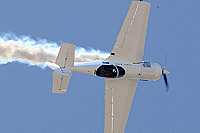 Post-show
note: Sadly display pilot Ian Groom lost his life in a practice display
accident on Saturday 1 May in preparation for the McDonald's Air &
Sea Show at Fort Lauderdale, Florida. Born to British parents in South
Africa, Groom was 39 years old and recognised as one of the USA's leading
aerobatic pilots.
Post-show
note: Sadly display pilot Ian Groom lost his life in a practice display
accident on Saturday 1 May in preparation for the McDonald's Air &
Sea Show at Fort Lauderdale, Florida. Born to British parents in South
Africa, Groom was 39 years old and recognised as one of the USA's leading
aerobatic pilots.
Home | Airshows | The Hangar | Nostalgia | Links